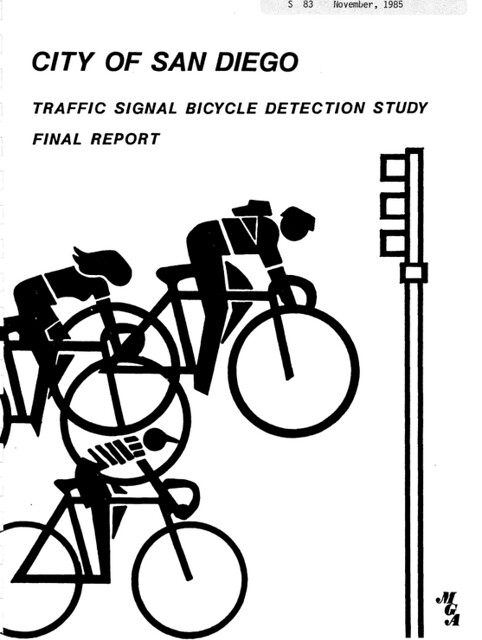There was a lot of interest in last Friday’s post about bicycle detection for traffic lights at intersections, in which I uploaded a report about the state-of-the-art in 1985.

There was a lot of interest in last Friday’s post about bicycle detection for traffic lights at intersections, in which I uploaded a report about the state-of-the-art in 1985.

Longtime California cyclist advocate Bob Shanteau sent this 1985 report on traffic signal bicycle detection and asked me to archive it here at Cyclelicious.

Most cyclists have encountered stubborn traffic lights that don’t detect bicycles or motorcycles. Since 2009 in California, new traffic lights that detect traffic must also detect bicycles and motorcycles. This law requiring bicycle detection for actuated traffic lights has encouraged some additional innovation by traffic equipment vendors.
To comply with state law while maintaining a high level of vehicle throughput at busy intersections, the city of Pleasonton, CA experimented with a radar device that can differentiate between bicycles and automobiles, and provides longer green light times for bikes to allow them to safely cross large intersections. The city now has several intersections with the bicycle differentiating technology provided by their vendor MS SEDCO.
Another traffic equipment company, Interis Iteris, announced their SmartCycle bicycle detection for video traffic signal controls. Their SmartCycle uses existing Iteris video detectors and other hardware to differentiate between bikes and cars and offer longer green light time for bicycles. Says their marketing material:
Cyclists are becoming more prevalent across the country and extra phase time is needed to allow them to safely exit the intersection on. When no bicyclists are present the additional cycle time is wasted reducing efficiency of the traffic network. Reclaiming this unused time can greatly improve traffic flow while ensuring the safety of the cycling public.
According to Iteris, this additional capability is a simple firmware upgrade for existing equipment that can be used for their entire Vantage detection family of video detection processor products, including: Edge2, SmartSpan, Vector, and VersiCam. Iteris is offering this firmware upgrade to their existing users at no cost.
Iteris points out California’s requirement for bicycle detection for traffic lights that are actuated by traffic. AB 1581 became effective in 2009; this law requires that when traffic-actuated signals are first installed or are replaced that they must be capable of detecting bicycles and motorcycles as well as motor vehicles. I love this part of their FAQ which answers the question “Why should I care about this outside of California?”
Bicyclists do legally operate on roadways in your jurisdiction. Their acceleration from a stopped position, as well as their design speed, is much slower than the rest of the traffic stream. In order for bicycles to be safely accommodated at signalized intersections (an undeniable goal), the phase timing must be adjusted upward to provide for these slower vehicle characteristics. In particular, the minimum green time and the final passage time must both be set to be longer than they would be for a traffic stream that is composed only of ‘regular’ motor vehicles. If the detection presence of bicycles is non-existent at a traffic signal, the only way that their safety can be provided for is for their presence to be assumed on every signal cycle. This would lead to more sluggish timing of the traffic signal, and create a significant amount of extra delay to the rest of the traffic stream. Detecting bicycles accurately, and only providing the extra time when they are present, keeps the traffic signal operating at improved efficiency and throughput. So, detecting bicycles achieves a dual goal – to accommodate this slower class of lawful vehicles with appropriate safety, and to keep traffic signals operating as efficiently as possible in the absence of bicycles. Either goal by itself is sufficient reason for all actuated signals – nationwide, not just in California – to be equipped with robust detection of bicycles.
Read more about Iteris SmartCycle here. I’m happy to see companies like Iteris and MS SEDCO creating traffic control technology with bikes in mind.
In a recent N.Y. Times article, writer Allison Arieff laments that industrial designers have created too many precious, useless objects and calls for a return to “problem-solving” design. The article’s spirit is right in keeping with the cycling business trend towards commuter, cruiser and cargo bikes.
Maybe one way the recession as good for design is to see it not as a form of punishment for frivolous designers but rather as an opportunity to allow for a rethinking of design itself — and the role of the designer within it.
This rethinking needs to come not just from designers but from the manufacturers, companies and other clients who decide what products and projects will be produced. There’s no excuse not to examine and re-examine what’s made, how it’s manufactured, what materials are used (and which are recyclable), what benefit it’s giving the consumer (or lack thereof) and what contribution, if any, it’s making to anything other than landfill.
Arieff’s article places the bicycle industry’s reconsideration of its product lines in the context of a larger societal shift towards more sensible, practical products. Anyone who has seen the latest crop of utility bikes can agree that “The work that springs from this sort of questioning does not have to sacrifice beauty for utility, vision for practicality.”